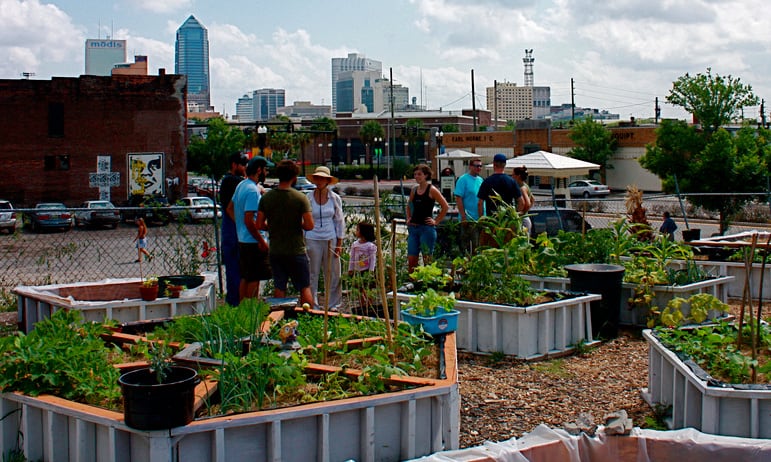Getting My City Blooming To Work
Getting My City Blooming To Work
Blog Article
The Best Guide To City Blooming
Table of ContentsHow City Blooming can Save You Time, Stress, and Money.Things about City BloomingRumored Buzz on City BloomingLittle Known Facts About City Blooming.How City Blooming can Save You Time, Stress, and Money.
Interested in growing food offer for sale in the City of Chicago? Thinking of beginning a neighborhood garden? Adjustments to the Chicago Zoning Ordinance permit agricultural uses like neighborhood gardens and city ranches in several components of the city. Below is a listing of often asked inquiries regarding the guidelines and guidelines that cultivators must take into consideration when intending a city agriculture project.
The zoning amendment does not customize any kind of various other codes handling composting, structure authorizations, purchasing or leasing City had home, business licenses or environmental contamination. There are existing codes that control these problems and they continue to be completely result and may be suitable to your project. Community gardens are generally had or taken care of by public entities, civic organizations or community-based organizations and kept by volunteers.
Urban farms grow food that is planned to be offered, either on a nonprofit or for-profit basis. Due to their business objective, city ranches need a service license. Yes. An area yard is allowed to market surplus generate that was grown on site if the sales are accessory or subservient to the garden's key purpose explained over.
The Main Principles Of City Blooming
Composting is allowed however just for plant material that is generated and used on site. The amount of garden compost material can not exceed 25 cubic lawns at any type of provided time according to the standards in 7-28-715 of the City's Municipal Code. Yes. Since the dirt at the majority of new yard websites needs modifying, garden compost, soil, timber chips, or various other products can be acquired to construct or enhance the growing area - fruit and vegtables.

If a building authorization is needed then the hoophouse will certainly be thought about an accessory structure. You can discover more concerning the structure authorization requirements by contacting the Department of Buildings. The 25,000-square-foot size limitation is planned to stop a solitary community garden from controling a given block or interfering with the block's existing domestic or commercial personality.
The limitation does not apply to yards located in Public Open Area (POS) areas. Can there be even more than one area garden that is 25,000 square feet on a single block? Fencing is not needed, nonetheless, gardens that have huge vehicle parking areas might be called for to mount fencing or various other landscaping features.
Not known Details About City Blooming
B1 & B2 areas require that all industrial use tasks be conducted inside. Is secure fencing required for metropolitan ranches? Fences may be needed, along with landscape design and screening, for particular parking locations and exterior work or storage locations depending on place and the particular task taking location.
Yes. Urban farms require structure authorizations and zoning authorizations prior to building. Various other kinds of city testimonial might be needed depending upon particular structures, activities, size, landscape design, licensing, public heath and stormwater management problems. Several of these requirements are identified in the project layout or allowing procedure, nevertheless, the applicant might be responsible to individually determine certain licenses or allows that might be needed.
The Division of Business Matters and Customer Defense can help figure out the certain type of business certificate that's required. Off street parking is required for the majority of commercial projects in Chicago. The called for number of car park spaces is based on the number of employees working on site and not the square footage of the growing room.
The Ultimate Guide To City Blooming

Yes. An urban ranch can market compost product created on website, nonetheless, the procedure should comply with the laws in 7-28-715 of the Chicago Municipal Code. Yes. Aquaponic systems are permitted indoors on urban farms in numerous zoning districts. Nevertheless, a zoning review and this contact form structure permit is needed in order to mount structures or systems and a company permit is called for as defined over.
Up to five hives or nests of honey bees may be maintained as an accessory use. Nevertheless, beekeepers should register with the Illinois Division of Agriculture. For additional information about the suggested zoning modification you might call the Department of Real Estate and Economic Advancement, Bureau of Preparation and Zoning at 312.744.8563.
Farming in cities and urban areas A metropolitan ranch in Chicago. Urban farming describes various methods of cultivating. https://www.edocr.com/v/rklelljq/danielnold94107/city-blooming, processing, and distributing food in urban locations. The term also applies to the location tasks of animal husbandry, aquaculture, beekeeping, and cultivation in a city context. Urban agriculture is identified from peri-urban farming, which occurs in country areas at the edge of residential areas.
Things about City Blooming
It can entail a movement of natural farmers, "foodies" and "locavores", that seek to develop social media networks based on a common ethos of nature and neighborhood holism. These networks can develop by means of formal institutional support, becoming integrated right into neighborhood town as a "change town" movement for sustainable metropolitan development.
In either instance, the extra direct accessibility to fresh veggie, fruit, and meat products that may be understood with metropolitan agriculture can enhance food safety and food safety and security while reducing food miles, resulting in reduced greenhouse gas exhausts, consequently adding to climate adjustment mitigation. Some of the first proof of metropolitan farming comes from Mesopotamia.
Report this page